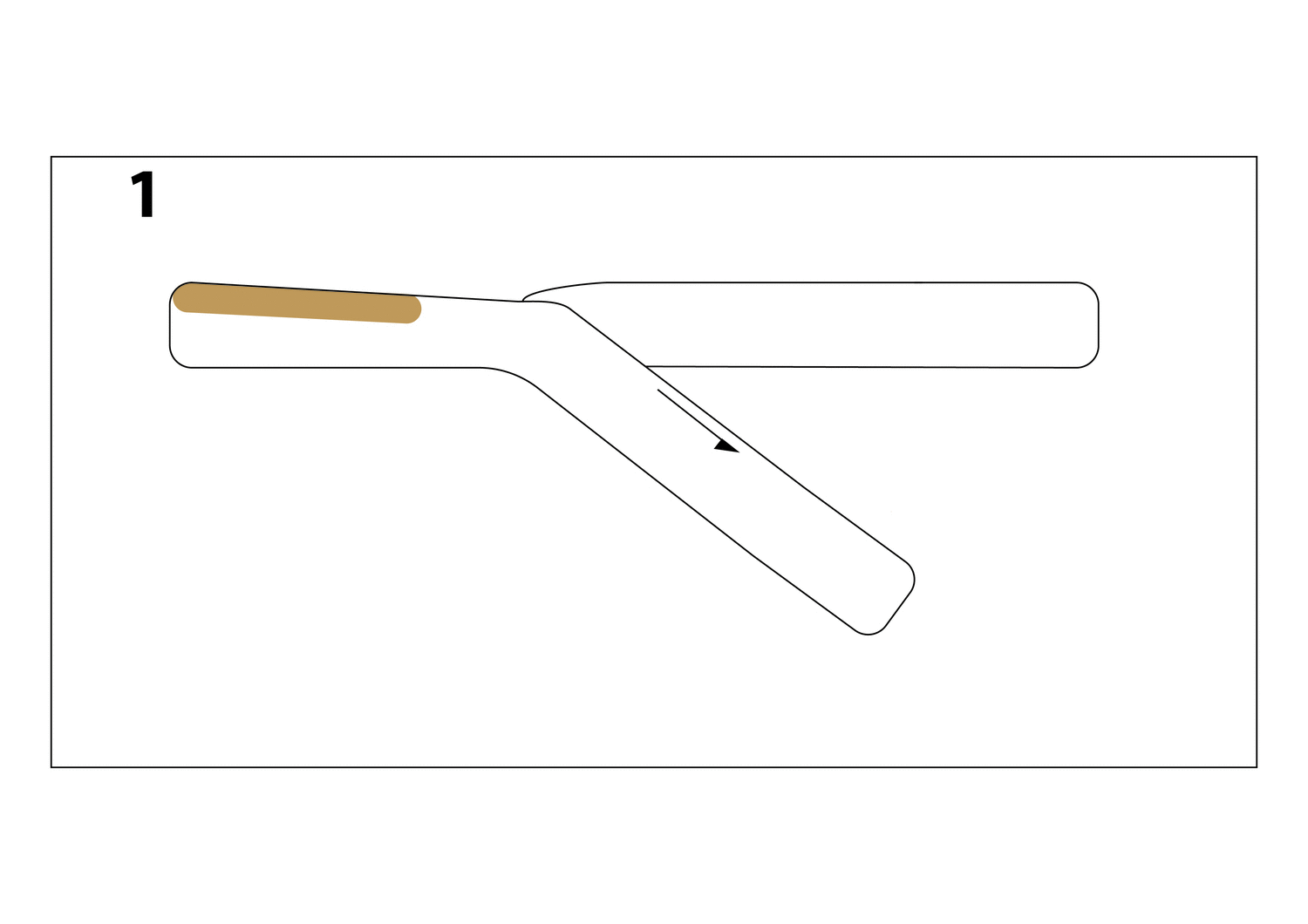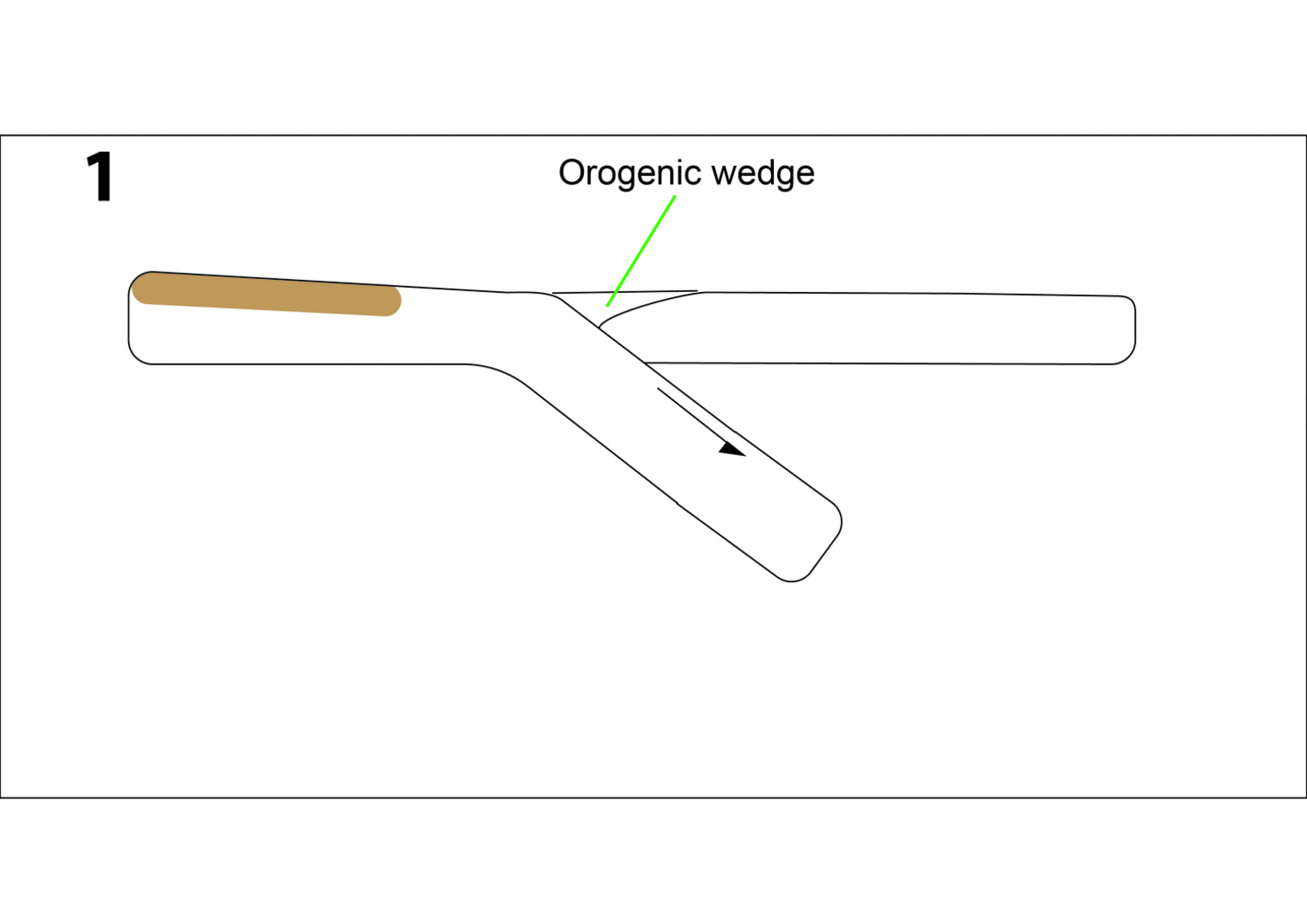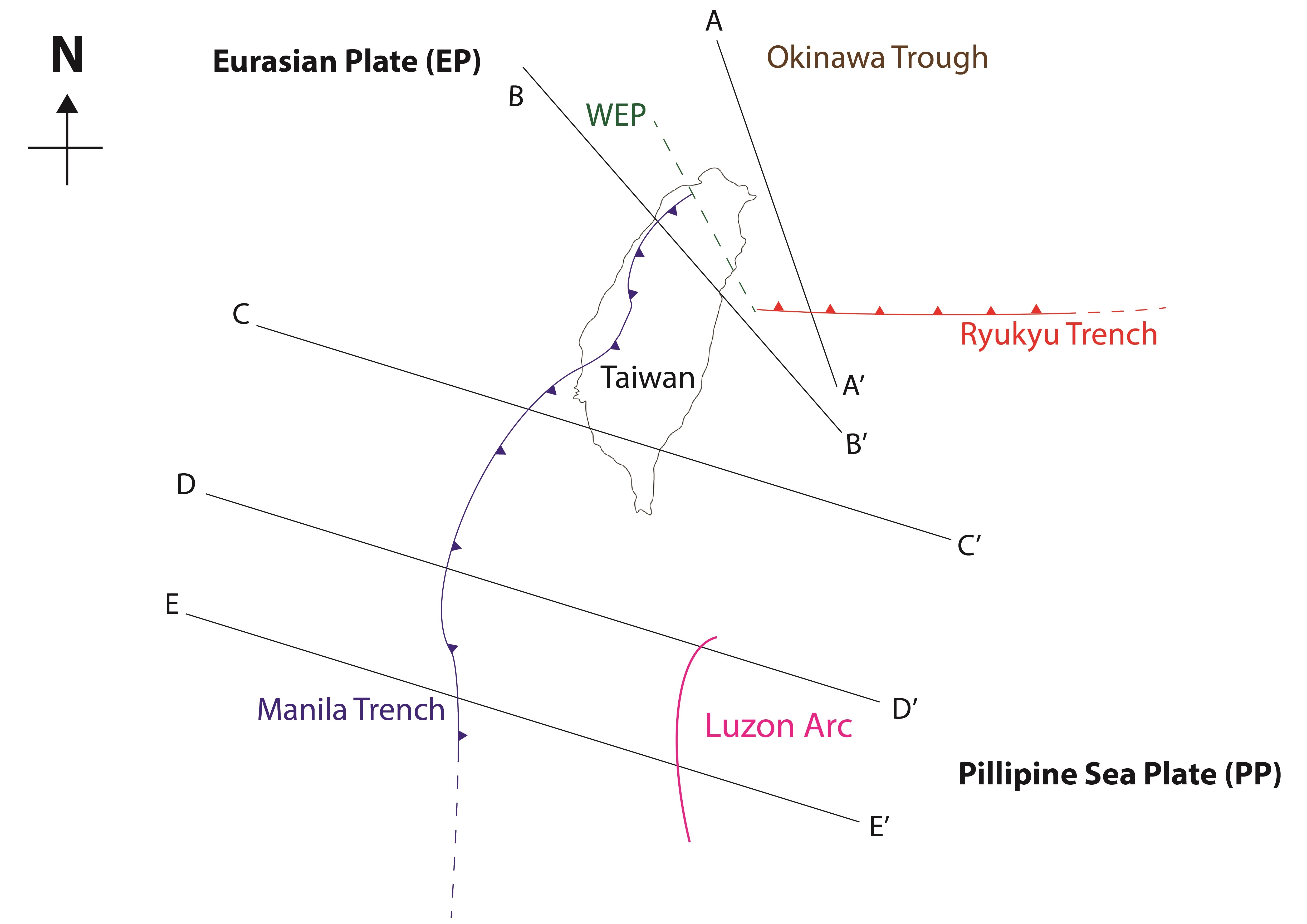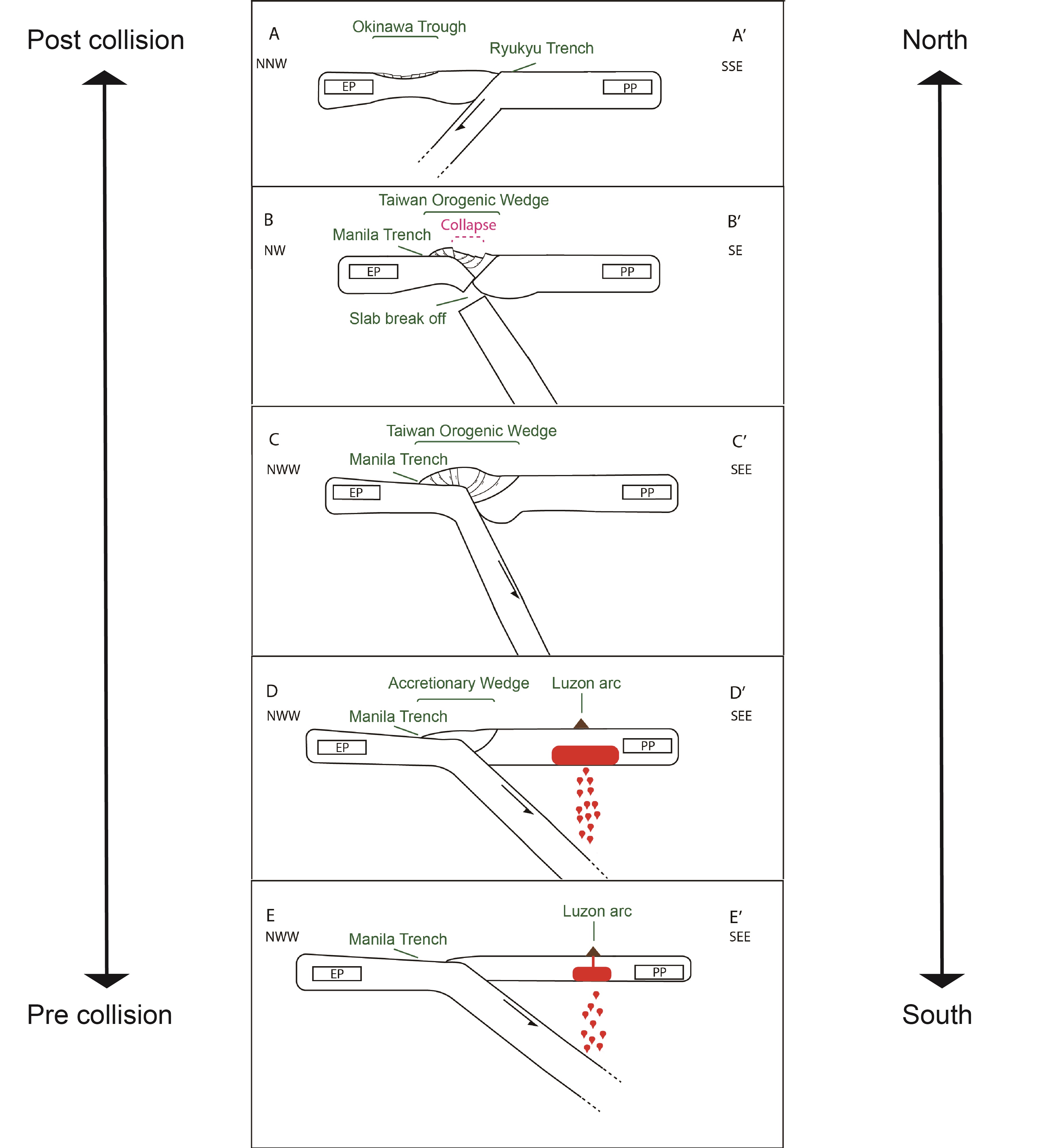Subduction Polarity Reversal on:
[Wikipedia]
[Google]
[Amazon]
 Subduction polarity reversal is a geologic process in which two converging plates switch roles: The over-lying plate becomes the down-going plate, and vice versa. There are two basic units which make up a
Subduction polarity reversal is a geologic process in which two converging plates switch roles: The over-lying plate becomes the down-going plate, and vice versa. There are two basic units which make up a



 A sharp contrast of landforms in Taiwan lures many people to investigate. The northern part of Taiwan has many flat plains such as Ilan Plain and Pingtung Plain, while the southern part of Taiwan is concentrated with many high mountains like Yushan reaching about 3950m. This huge difference in topography is the consequence of the flipping of subduction polarity. Most of models studying this phenomenon will focus on an active collision in Taiwan which appears to reveal the incipient stages of subduction reversal.
The collision of N- trending Luzon arc in
A sharp contrast of landforms in Taiwan lures many people to investigate. The northern part of Taiwan has many flat plains such as Ilan Plain and Pingtung Plain, while the southern part of Taiwan is concentrated with many high mountains like Yushan reaching about 3950m. This huge difference in topography is the consequence of the flipping of subduction polarity. Most of models studying this phenomenon will focus on an active collision in Taiwan which appears to reveal the incipient stages of subduction reversal.
The collision of N- trending Luzon arc in 
subduction zone
Subduction is a geological process in which the oceanic lithosphere is recycled into the Earth's mantle at convergent boundaries. Where the oceanic lithosphere of a tectonic plate converges with the less dense lithosphere of a second plate, ...
. This consists of an overriding plate and the subduction plate. Two plates move towards each other due to tectonic forces. The overriding plate will be on the top of the subducting plate. This type of tectonic interaction is found at many plate boundaries.
However, some geologists propose that the roles of the overriding plate and subducting plate do not remain the same indefinitely. Their roles will swap, which means the plate originally subducting beneath will become the overriding plate. This phenomenon is called subduction switch, the flipping of subduction polarity or subduction polarity reversal.
Examples of subduction systems with subduction polarity reversal are:
* Caledonides, Ireland
* Alps-Apennines, Italy
* Kamchatka
The Kamchatka Peninsula (russian: полуостров Камчатка, Poluostrov Kamchatka, ) is a peninsula in the Russian Far East, with an area of about . The Pacific Ocean and the Sea of Okhotsk make up the peninsula's eastern and west ...
, Russia
* Wetar
Wetar is a tropical island which belongs to the Indonesian province of Maluku and is the largest island of the Maluku Barat Daya Islands (literally ''Southwest Islands'') of the Maluku Islands. It lies east of the Lesser Sunda Islands, which i ...
, eastern Indonesia
* Timor
Timor is an island at the southern end of Maritime Southeast Asia, in the north of the Timor Sea. The island is divided between the sovereign states of East Timor on the eastern part and Indonesia on the western part. The Indonesian part, al ...
, east Savu Sea
* Mediterranean
The Mediterranean Sea is a sea connected to the Atlantic Ocean, surrounded by the Mediterranean Basin and almost completely enclosed by land: on the north by Western and Southern Europe and Anatolia, on the south by North Africa, and on th ...
* Taiwan
Taiwan, officially the Republic of China (ROC), is a country in East Asia, at the junction of the East and South China Seas in the northwestern Pacific Ocean, with the People's Republic of China (PRC) to the northwest, Japan to the northe ...
Background
The phenomenon of subduction polarity reversal has been identified in the collision of an intra-oceanic subduction system, which is the collision of two oceanic plates. When two oceanic plates migrate towards each other, one subducts below the other. Generally, the oceanic plate with higher density subducts beneath and the other one overrides the down-going slab. The process continues until a buoyantcontinental margin
A continental margin is the outer edge of continental crust abutting oceanic crust under coastal waters. It is one of the three major zones of the ocean floor, the other two being deep-ocean basins and mid-ocean ridges. The continental marg ...
sitting on the top of the subducting plate is introduced into the down-going slab. The subduction of the slab becomes slower and may even cease. Geologists propose various possible models to predict what will be the next step for the intra-oceanic subduction system with the involvement of buoyant continental crust
Continental crust is the layer of igneous, sedimentary, and metamorphic rocks that forms the geological continents and the areas of shallow seabed close to their shores, known as continental shelves. This layer is sometimes called '' sial' ...
. One of the possible results is subduction polarity reversal.
Models of subduction polarity reversal
Even though many geologists agree that after the involvement of buoyantcontinental crust
Continental crust is the layer of igneous, sedimentary, and metamorphic rocks that forms the geological continents and the areas of shallow seabed close to their shores, known as continental shelves. This layer is sometimes called '' sial' ...
, subduction polarity reversal may occur, they have different opinions towards the mechanisms leading to the change of subduction direction. Thus, there is no single model to represent subduction polarity reversal. How geologists develop the models depends on the parameters they focus on. Some geologists attempt to construct models of subduction reversal through laboratory experiments or observations. There are three common models: slab break-off, double convergence and lithospheric break-up.
The models of slab-break up and double convergence are based on observations by geologists, and the lithosphere break-up model is based on experimental simulation
A simulation is the imitation of the operation of a real-world process or system over time. Simulations require the use of models; the model represents the key characteristics or behaviors of the selected system or process, whereas the ...
.
The criteria for having subduction polarity reversal are
# Intra-oceanic subduction system with a buoyant continental plate
# Subduction system ceases with the involvement of continental plate
# Old slab breaks off
In addition to the criteria for the occurrence of subduction polarity reversal, some geologists have attempted to define controls of this phenomenon’s initiation. Zhang proposes that “the plastic strength and age of the overriding oceanic plate in the arc-continent collision system control the initiation modes.” When the whole overriding oceanic plate has a small plastic strength and younger oceanic plate it prefers a “spontaneous subduction polarity reversal”. This is because the lack in plastic strength allows negative buoyancy to overcome and “spontaneously initiate” subduction. while the stronger plastic strength and older oceanic plate prefers an “induced subduction polarity reversal. This is because the stronger plastic strength in the oceanic plate, the more it will resist a “spontaneous subduction”, making it necessary for a compression induced subduction polarity reversal.
Different models representing the subduction polarity reversal depends highly on parameters the Geologists considered. Here is the summary table showing the comparison models.
Slab break-off
This model was developed by analyzing the geological cross section along the collision betweenEurasian plate
The Eurasian Plate is a tectonic plate that includes most of the continent of Eurasia (a landmass consisting of the traditional continents of Europe and Asia), with the notable exceptions of the Indian subcontinent, the Arabian subcontinent and ...
and the Philippine sea plate
The Philippine Sea Plate or the Philippine Plate is a tectonic plate comprising oceanic lithosphere that lies beneath the Philippine Sea, to the east of the Philippines. Most segments of the Philippines, including northern Luzon, are part of ...
, which is the location of an ongoing flipping of subduction polarity.
When two oceanic plates migrate towards each other, one plate overrides another forming a subduction system. Later, a light and buoyant passive continental margin introduced into this system will cause the cessation of subduction system. On one hand, the buoyant plate resists subduction beneath the overriding plate. On the other hand, the dense oceanic slab at the subducting plate prefers to move downward. These opposite forces will generate a tensile force or gravitational instability on the downward slab and lead to the break-off of the slab. The space where the break-off slab separates will form a mantle window. Subsequently, the less dense continental margin forms the overriding plate, while the oceanic plate becomes the subducting slab. The direction of the subduction system changes since the break-off of slab creates the space, which is the major parameter of this model.
Double convergence model
This model is developed based on the geological evolution of Alpine and Apennine subduction. Similarly, two oceanic plates move towards each other. The subduction process ceases with the involvement of buoyant continental block. A new slab is formed at the overriding plate owing to the regional compression and the difference in density between the continental block and oceanic plate. An orogenic wedge is built. However, there is an obvious space problem about how to accommodate two slabs. The solution is the new developing slab moves not only vertically, but also laterally leading to a deep strike-slip movement. The development of co-existence of two opposite slabs is described as a double sided subduction or doubly convergent wedge. Eventually, the development of new slab grows and slides onto the old slab. The old slab breaks off and the orogenic wedge collapses. The new slab stops the lateral motion and subducts beneath. The direction of subduction system changes.
Lithosphere break-up
The lithosphere break-up model is simulated by hydrocarbon experiments in the laboratory. The researchers set up the setting of subduction zone which are analogized by hydrocarbons with different densities representing various layers in thesubduction zone
Subduction is a geological process in which the oceanic lithosphere is recycled into the Earth's mantle at convergent boundaries. Where the oceanic lithosphere of a tectonic plate converges with the less dense lithosphere of a second plate, ...
.
The initial setting of the simulated subduction zone
Subduction is a geological process in which the oceanic lithosphere is recycled into the Earth's mantle at convergent boundaries. Where the oceanic lithosphere of a tectonic plate converges with the less dense lithosphere of a second plate, ...
model is confined by two pistons. The piston connected to the overriding plate is locked, while the piston linking to subducting plate is subjected to a constant rate of compression. More importantly, there is a relatively thin magmatic arc and pre-existing fault dipping towards the subducting plate at the overriding plate. The detachment of the pre-existing fault occurs when buoyant continental margin
A continental margin is the outer edge of continental crust abutting oceanic crust under coastal waters. It is one of the three major zones of the ocean floor, the other two being deep-ocean basins and mid-ocean ridges. The continental marg ...
is in contact with the overriding plate. It is because the buoyant margin resists subduction
Subduction is a geological process in which the oceanic lithosphere is recycled into the Earth's mantle at convergent boundaries. Where the oceanic lithosphere of a tectonic plate converges with the less dense lithosphere of a second plate, ...
and significantly increases the frictional force in the contact region. The subduction then stops. Subsequently, the new subducting slab develops at an overriding plate with the continuous compression. The new developing slab eventually penetrates and breaks the old slab. A new subduction zone is formed with an opposite polarity to the previous one.
In reality, the magmatic arc is a relatively weak zone at the overriding plate because it has a thin lithosphere and is further weakened by high heat flow and hot fluid. Pre-existing faults in this simulation are also common in the magmatic arc. This experiment is a successful analogy to subduction polarity reversal happening at Kamchatka in early Eocene and the active example at Taiwan region as well as at Timor.
Taiwan as an active example of flipping of subduction reversal
 A sharp contrast of landforms in Taiwan lures many people to investigate. The northern part of Taiwan has many flat plains such as Ilan Plain and Pingtung Plain, while the southern part of Taiwan is concentrated with many high mountains like Yushan reaching about 3950m. This huge difference in topography is the consequence of the flipping of subduction polarity. Most of models studying this phenomenon will focus on an active collision in Taiwan which appears to reveal the incipient stages of subduction reversal.
The collision of N- trending Luzon arc in
A sharp contrast of landforms in Taiwan lures many people to investigate. The northern part of Taiwan has many flat plains such as Ilan Plain and Pingtung Plain, while the southern part of Taiwan is concentrated with many high mountains like Yushan reaching about 3950m. This huge difference in topography is the consequence of the flipping of subduction polarity. Most of models studying this phenomenon will focus on an active collision in Taiwan which appears to reveal the incipient stages of subduction reversal.
The collision of N- trending Luzon arc in Philippine Sea plate
The Philippine Sea Plate or the Philippine Plate is a tectonic plate comprising oceanic lithosphere that lies beneath the Philippine Sea, to the east of the Philippines. Most segments of the Philippines, including northern Luzon, are part of ...
(PP) with E-trending Eurasian plate
The Eurasian Plate is a tectonic plate that includes most of the continent of Eurasia (a landmass consisting of the traditional continents of Europe and Asia), with the notable exceptions of the Indian subcontinent, the Arabian subcontinent and ...
(EP) started at mid-Miocene forming an intra-oceanic subduction system. Taiwan was formed by this process. The south–north topographic difference in Taiwan is like a story book telling the evolution in subduction zone. The Philippine Sea plate
The Philippine Sea Plate or the Philippine Plate is a tectonic plate comprising oceanic lithosphere that lies beneath the Philippine Sea, to the east of the Philippines. Most segments of the Philippines, including northern Luzon, are part of ...
subducts below the Eurasian plate
The Eurasian Plate is a tectonic plate that includes most of the continent of Eurasia (a landmass consisting of the traditional continents of Europe and Asia), with the notable exceptions of the Indian subcontinent, the Arabian subcontinent and ...
at south-west part of WEP (Western edge of north-dipping Philippine Sea Plate), and the latter overrides the former at north east part of WEP. The collision between two plates started at the Northern Taiwan and propagated south with the younger region at the southern part. Each incipient stage of subduction reversal process could be studied by correlating cross-sections in various parts of Taiwan.

See also
*Geology of Taiwan
The island of Taiwan was formed approximately 4 to 5 million years ago at a convergent boundary between the Philippine Sea Plate and the Eurasian Plate. In a boundary running the length of the island and continuing southwards, the Eurasian ...
* Subduction erosion
Tectonic erosion or subduction erosion is the loss of crust from an overriding tectonic plate due to subduction. Two types of tectonic erosion exist: frontal erosion at the outer margin of a plate and basal erosion at the base of the plate's crus ...
* Wilson cycle
References
{{Reflist, 30em Subduction